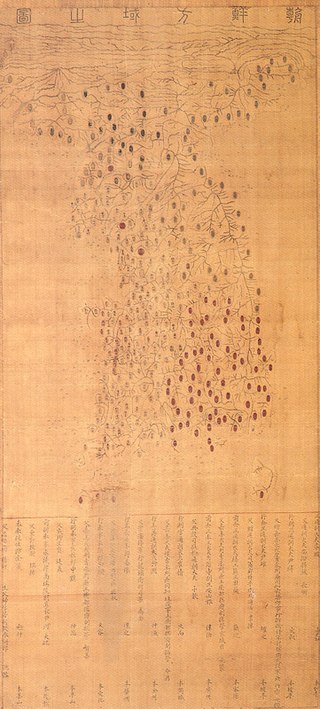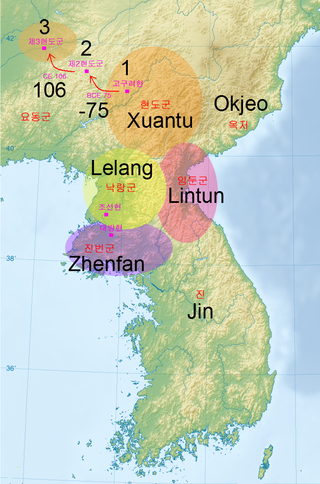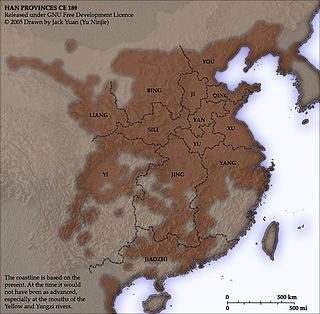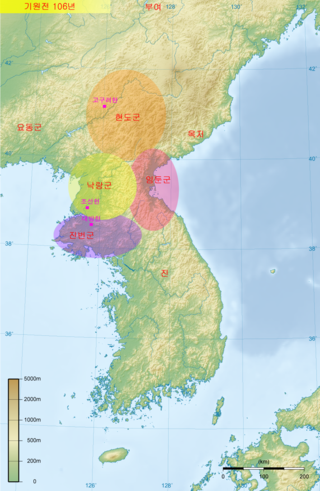
The Lower Paleolithic era on the Korean Peninsula and in Manchuria began roughly half a million years ago. The earliest known Korean pottery dates to around 8000 BC, and the Neolithic period began after 6000 BC, followed by the Bronze Age by 2000 BC, and the Iron Age around 700 BC.

Goguryeo also later known as Goryeo, was a Korean kingdom located in the northern and central parts of the Korean Peninsula and the southern and central parts of modern day Northeast China. At its peak of power, Goguryeo controlled most of the Korean Peninsula, large parts of Manchuria and parts of eastern Mongolia and Inner Mongolia as well as Russia.

The Lelang Commandery was a commandery of the Han dynasty established after it had conquered Wiman Joseon in 108 BC and lasted until Goguryeo conquered it in 313. The Lelang Commandery extended the rule of the Four Commanderies of Han as far south as the Han River in present-day South Korea. South Korean scholars have described its administrative areas as being limited to the Pyongan and Hwanghae regions, whose southern bounds lie roughly 75 miles north of the Han River.
The Daifang Commandery was an administrative division established by the Chinese Han dynasty on the Korean Peninsula between 204 and 314.
Wi Man or Wei Man was a Chinese-born Korean military general and monarch. He was originally a military leader of the Chinese Kingdom of Yan. When king Lu Wan of Yan was defeated by the Han in 195 BCE, Wi Man fled to Gojoseon in north-western Korea and later usurped power from its king in 194 BCE, establishing Wiman Joseon. Recorded in the Records of the Grand Historian and the Book of Han, Wiman was the first ruler in the history of Korea to have been recorded in documents from the same time period.

Gojoseon, also called Joseon, was the first kingdom on the Korean Peninsula. According to Korean mythology, the kingdom was established by the legendary founder named Dangun. Gojoseon possessed the most advanced culture in the Korean Peninsula at the time and was an important marker in the progression towards the more centralized states of later periods. The addition of Go, meaning "ancient", is used in historiography to distinguish the kingdom from the Joseon dynasty founded in 1392 CE.

Wiman Joseon was a dynasty of Gojoseon. It began with Wiman's seizure of the throne from Gija Joseon's King Jun and ended with the death of King Ugeo who was a grandson of Wiman. Apart from archaeological data, the main source on this historical period comes from chapter 115 of Sima Qian's Records of the Grand Historian. Wiman was originally a Chinese military leader from the Kingdom of Yan under the Han dynasty.

Buyeo or Puyŏ, also rendered as Fuyu, was an ancient kingdom that was centered in northern Manchuria in modern-day northeast China. It is sometimes considered a Korean kingdom, and had ties to the Yemaek people, who are considered to be the ancestors of modern Koreans. Buyeo is a major predecessor of the Korean kingdoms of Goguryeo and Baekje.

Ye or Dongye, which means the Eastern Ye, was a Korean chiefdom which occupied portions of the northeastern Korean peninsula from roughly 3rd-century BC to around early 5th-century AD. It bordered Goguryeo and Okjeo to the north, Jinhan to the south, and China's Lelang Commandery to the west. Today, this territory consists of the provinces of South Hamgyŏng and Kangwon in North Korea, and Gangwon in South Korea.

Okjeo was an ancient Korean tribal state which arose in the northern Korean peninsula from perhaps the 2nd century BCE to the 5th century CE.

Korea's military history spans thousands of years, beginning with the ancient nation of Gojoseon and continuing into the present day with the countries of North Korea and South Korea, and is notable for its many successful triumphs over invaders. Throughout its history, Korea has boasted numerous exceptional leaders who gained outstanding victories against numerically superior enemies. Famed leaders credited with defending Korea against foreign invasions include: Eulji Mundeok of Goguryeo, who defeated Sui China during the Goguryeo–Sui War; Yeon Gaesomun of Goguryeo, who defeated Emperor Taizong of Tang China during the Goguryeo–Tang War; Gang Gam-chan of Goryeo, who defeated the Khitan Empire during the Goryeo-Khitan War; Choe Yeong and Yi Seong-gye of Goryeo, who defeated the Red Turbans during the Red Turban Invasions; and Yi Sun-shin of Joseon, who defeated the Japanese at sea during the Imjin War. Other notable leaders include: Gwanggaeto the Great of Goguryeo, who created a great empire in Northeast Asia through conquest, and subjugated the other Korean kingdoms of Baekje, Silla and Gaya to bring about a brief unification of the Three Kingdoms of Korea; Geunchogo of Baekje, who captured Pyongyang and established overseas territories to control much of the Korean peninsula and dominate the seas; Munmu and Kim Yu-sin of Silla, who united the Three Kingdoms of Korea and defeated Tang China to gain complete control of the Korean peninsula; Dae Jo-yeong, who created Balhae from Goguryeo's ashes and reconquered Goguryeo lands lost during the Goguryeo-Tang War; Jang Bogo of Later Silla, who created a maritime empire and commanded a powerful fleet; Wang Geon, who united the Later Three Kingdoms of Korea and established Goryeo as the successor to Goguryeo; and Yun Gwan of Goryeo, who defeated the Jurchens and constructed nine fortresses in Manchuria.

You Prefecture or YouProvince, also known by its Chinese name Youzhou, was a prefecture (zhou) in northern China during its imperial era.

The Four Commanderies of Han were Chinese commanderies located in the north of the Korean Peninsula and part of the Liaodong Peninsula from around the end of the second century BC through the early 4th AD, for the longest lasting. The commanderies were set up to control the populace in the former Gojoseon area as far south as the Han River, with a core area at Lelang near present-day Pyongyang by Emperor Wu of the Han dynasty in early 2nd century BC after his conquest of Wiman Joseon. As such, these commanderies are seen as Chinese colonies by some scholars. Though disputed by North Korean scholars, Western sources generally describe the Lelang Commandery as existing within the Korean peninsula, and extend the rule of the four commanderies as far south as the Han River. However, South Korean scholars assumed its administrative areas to Pyongan and Hwanghae provinces.
The Goguryeo–Wei War was a series of invasions of Goguryeo from 244 to 245 launched by Cao Wei.

Xuantu Commandery was a commandery of the Chinese Han dynasty. It was one of Four Commanderies of Han, established in 107 BCE in the northern Korean Peninsula and part of the Liaodong Peninsula, after the Han dynasty conquered Wiman Joseon. Goguryeo rose in this area in competition with the Han dynasty over the region. Although Goguryeo gained full control over the general region in 302, the Eastern Han dynasty had already lost the earlier territory of Xuantu, which retreated to Liaodong Peninsula in the 1st century CE. The populations of the respective prefectures were greatly reduced after they were transferred to Liaodong, but their prefectural identities were preserved albeit nominally.

Gaogouli County was a county of the Chinese Han dynasty under the administration of Xuantu Commandery located in southern Manchuria and the northern Korean Peninsula. It was established by the Han dynasty after its conquest of Gojoseon to keep the tribes of Goguryeo (Gaogouli) in check. In 75 BC, Xuantu Commandery was forced to move its seat of power from Fort Okjeo to Gaogouli County due to Yemaek raids. From 75 BC to 12 AD, Goguryeo tribes were under administration of Gaogouli County and engaged in tributary relationship with the Han dynasty. In 12 AD, Goguryeo rebelled against the Han dynasty and established its own kingdom, and in 105 AD, began attacking the Chinese commanderies of Xuantu and Liaodong. Later, in the 4th century, the State of Goguryeo conquered Xuantu Commandery, along with the Liaodong and Lelang commanderies, ending Han rule over the Liaodong Peninsula and the Korean Peninsula.

The Han conquest of Gojoseon was a campaign launched by Emperor Wu of Han China against Wiman Joseon between 109 and 108 BCE. It resulted in the fall of Gojoseon and the establishment of the Four Commanderies of Han in the northern half of the Korean Peninsula.
The Canghai Commandery was an administrative division of the Chinese Han dynasty established by the Emperor Wu in 128 BC.

The Zhenfan Commandery was one of the Four Commanderies of the Chinese Han dynasty located on the Korean Peninsula. It existed between 108 BC and 82 BC.
Nakrang Kingdom was a kingdom located in the northwestern part of the Korean Peninsula according to Samguk Sagi. The kingdom's independence, however, is debated. According to the ancient Korean record of Samguk Sagi, the King of Nakrang named Choi Ri met the Prince Hodong of Goguryeo and let him marry his daughter, the Princess of Nakrang. When Prince Hodong asked the princess to break drums and horns in the Nakrang's armory to prevent the kingdom's guards from alerting the attack by Goguryeo, the princess followed Hodong's instructions, leading to Nakrang being conquered by Goguryeo.








